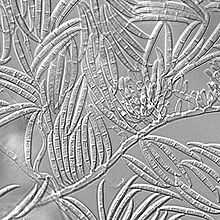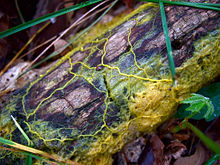Gibberella zeae
| Gibberella zeae | |
|---|---|
 | |
| Scientific classification | |
| Kingdom: | |
| Division: | |
| Class: | |
| Order: | |
| Family: | |
| Genus: | |
| Species: |
G. zeae
|
| Binomial name | |
| Gibberella zeae
(Schwein.) Petch, (1936)
| |
| Synonyms | |
| Botryosphaeria saubinetii Dichomera saubinetii Dothidea zeae Fusarium graminearum Fusarium roseum Gibbera saubinetii Gibberella roseum Gibberella saubinetii Sphaeria saubinetii Sphaeria zeae | |
Contents
Life cycle[edit]
F. graminearum is a haploid homothallic ascomycete. The fruiting bodies, perithecia, develop on the mycelium and give rise to ascospores, which land on susceptible parts of the host plant to germinate. The fungus causes fusarium head blight on wheat, barley, and other grass species, as well as ear rot on corn. The primary inocula are the ascospores, sexual spores which are produced in the perithecia.[4] Spores are forcibly discharged and can germinate within six hours upon landing on the plant surface. The scab disease is monocyclic; after one cycle of infection with ascospores, the fungus produces macroconidia by asexual reproduction.[5] These structures overwinter in the soil or in plant debris on the field and give rise to the mycelium in the next season.Host and symptoms[edit]
The pathogen is capable of causing a variety of diseases: head blight or 'scab' on wheat (Triticum), barley (Hordeum), rice (Oryza), oats (Avena), and Gibberella stalk and ear rot disease on maize (Zea). Additionally, the fungus may infect other plant species without causing any disease symptoms.[6]Maize
In Gibberella stalk rot, the leaves on early-infected plants will turn a dull greyish-green, and the lower internodes will soften and turn a tan to dark-brown. A pink-red discoloration occurs within the stalks of diseased tissue. Shredding of the pith may reveal small, round, black perithecia on the stalks.[7] Gibberella (red) ear rot can have a reddish mold that is often at the ear tip. The infection occurs by colonizing corn silk and symptoms first occur at the ear's apex. The white mycelium turns from pink to red over time, eventually covering the entire ear. Ears that become infected early don't fully develop the reddish mold near the ear tip, as the mold grows between the husks and ear.[6]
Rice
Gibberella zeae can turn affected seeds red and cause brown discoloration in certain areas on the seed or the entire seed surface. The surface of husks develop white spots that later become yellow and salmon or carmine. Infected grains are light, shrunken and brittle. Stem nodes begin to rot and wilt, eventually causing them to turn black and disintegrate when they are infected by the fungal pathogen.[7]
Wheat
Brown, dark purple-black necrotic lesions will form on the outer surface of the spikelets, what the wheat ear breaks up into. The lesions may be referred to as scabs, but this is not to be confused and associated with other scab diseases such as those with different host and pathogen. Head blight is visible before the spikes mature.[7] Spikelets begin to appear water-soaked before the loss of chlorophyll, which gives a white straw color. Peduncles that are directly under the inflorescence can become discolored into a brown-purple color. Tissues of the inflorescence typically become blighted into a bleached tan appearance, and the grain within it atrophies.[6] The awn will become deformed, twisted and curve in a downward direction.
Barley
Infections on barley are not always visible in the field. Similar to wheat, infected spikelets show a browning or water-soaked appearance. The infected kernels display a tan to dark brown discoloration. During long periods of wetness, pink to salmon-orange spore masses can be seen on the infected spikelets and kernels.[6] The cortical lesions of infected seeds become a reddish-brown in cool, moist soil. Warm soil can cause head blight to occur after emergence, and crown and basal culm rot can be observed in later plant development.[7]
Infection process[edit]
F. graminearum infects wheat spikes from anthesis through the soft dough stage of kernel development. The fungus enters the plant mostly through the flowers; however, the infection process is complex and the complete course of colonization of the host has not been described. Germ tubes seem not to be able to penetrate the hard, waxy surface of the lemma and palea which protect the flower. The fungus enters the plant through natural openings such as stomates, and needs soft tissue such as the flowers, anthers and embryo to infect the plant.[8] From the infected floret, the fungus can grow through the rachis and cause severe damage in a short period of time under favorable conditions. Upon germination of the spores on the anthers and the surface of the developing kernel, hyphae penetrate the epicarp and spread through the seed coat. Successively, the different layers of the seed coat and finally the endosperm are colonized and killed.[9]Management[edit]
The control of this disease can be achieved using a combination of the following strategies: fungicide applications, resistance breeding, proper storage, crop rotation, crop residue tillage, and seed treatment. The correct usage of fungicide applications against Fusarium head blight can reduce the disease by 50 to 60 percent.[10] Fusarium refers to a large genus of soil fungi that are economically important due to the profound effects they have on crops. Application of fungicides is necessary at early heading date for barley and early flowering for wheat, where the early application can limit the infection of the ear. Barley and wheat differ in fungicide application because of their differences in developmental traits.[11] The disease generally develops late in the season or during storage, so fungicide use is only effective in the early season. Management against insect pests such as ear borers, for corn, will also reduce the infection of the ear from wounds caused by insect feeding.[12]Cultivating a variety of hosts that are resistant to Fusarium head blight is one of the most evidence-based and cost-effective ways to manage the disease. Using varieties that have looser tusks that cover the ear are less vulnerable to Fusarium head blight. Once the crop has been harvested, it is essential to store it at low moisture, below 15%, as this will reduce the appearance of Gibberella zeae and Fusarium species in storage.[12]
Avoiding the planting of small grain crops following other small grain crops or corn and tillage of crop residue minimizes the chances of Fusarium head blight in environmentally favorable years. The rotation of small grains with soybean or other non-host crops has proven to reduce Fusarium head blight and mycotoxin contamination.[10] Crop rotation with the tillage of residue prevents crops from remaining to infect on the soil surface. Residues can provide an overwintering medium for Fusarium species to cause Fusarium head blight. As a result, the chances of infection are greatly improved in the succeeding small grain crop.[10] If minimal or no tillage occurs, the residue spreads and allows the fungus to overwinter on stalks and rotted ears of corn and produce spores.
The seeds (kernels) that colonize with the fungus have less resistance because of poor germination. Planting certified or treated seeds can reduce the amount of seedling blight, which is caused by the seeds colonized with the fungus. If it is necessary to replant seeds that were harvested from a Fusarium head blight infected field, then the seeds should be treated to avoid reoccurrence of the infection.[10]
Importance[edit]
The loss of yield and contamination of seed with mycotoxins, alongside reduced seed quality, are the main contributions to the impact of this disease. Two mycotoxins, trichothecene deoxynivalenol, a strong biosynthesis inhibitor, and zearalenone, an estrogenic mycotoxin, can be found in grains after Fusarium head blight epidemics.[13] Deoxynivalenol is a type of vomitoxin and, as its name states, is an antifeedant. Livestock that consume crops contaminated with vomitoxin become sick and refuse to eat anymore. Zearalenone is a phytoestrogen, mimicking mammals' estrogen. It can be disastrous if it gets into the food chain, as zearalenone causes abortions in pregnant females and feminization of males.[14]In 1982, a major epidemic affected 4 million hectares of the spring wheat and barely growing in the northern Great Plains of North Dakota, South Dakota, and Minnesota. The yield losses exceeded 6.5 million tons worth approximately $826 million, with total losses related to the epidemic near one billion dollars.[7] Years that followed this epidemic, reported losses that have been estimated between $200-$400 million annually. Losses in barley because of Fusarium head blight are large in part due to the presence of deoxynivalenol. Barley prices from 1996 in Minnesota fell from $3.00 to $2.75 per bushel if the mycotoxin was present and another $0.05 for each part per million of deoxynivalenol present.[7]
See also[edit]
References[edit]
- ^ Bai G, Shaner G (2004):Management and resistance in wheat and barley to Fusarium head blight. Annual Review of Phytopathology 42: 135-161 [1]
- ^ De Wolf ED, Madden LV, Lipps PE (2003): Risk assessment models for wheat Fusarium head blight epidemics based on within-season weather data. Phytopathology 93: 428-435. [2]
- ^ Beyer M, Aumann J (2008): Effects of Fusarium infection on the amino acid composition of winter wheat grain. Food Chemistry 111: 750-754. [3]
- ^ Beyer M, Verreet J-A (2005): Germination of Gibberella zeae ascospores as affected by age of spores after discharge and environmental factors. European Journal of Plant Pathology 111: 381-389. [4]
- ^ Beyer M, Röding S, Ludewig A, Verreet J-A (2004): Germination and survival of Fusarium graminearum macroconidia as affected by environmental factors. Journal of Phytopathology 152: 92-97.[5]
- ^ Jump up to: a b c d Rubella, Goswami; Kistler, Corby (2004). "Heading for disaster: Fusarium graminearum on cereal crop" (PDF). Molecular Plant Pathology. 5 (6): 515–525. doi:10.1111/J.1364-3703.2004.00252.X. PMID 20565626.
- ^ Jump up to: a b c d e f "headblight of maize (Gibberella zeae)". www.plantwise.org. Retrieved 2017-10-25.
- ^ Bushnell WR, Leonard KJ (2003): Fusarium head blight of wheat and barley.APS Press, St. Paul, Minnesota
- ^ Jansen C, Von Wettstein D, Schäfer W, Kogel K-H, Felk A, Maier FJ (2005): Infection patterns in barley and wheat spikes inoculated with wild-type and trichodiene synthase gene disrupted Fusarium graminearum. Proceedings of the National Academy of Sciences 102: 16892-16897 [6]
- ^ Jump up to: a b c d "Managing Fusarium Head Blight in Virginia Small Grains". Retrieved 2017-10-25.
- ^ Alqudah, Ahmad M.; Schnurbusch, Thorsten (2017-05-30). "Heading Date Is Not Flowering Time in Spring Barley". Frontiers in Plant Science. 8: 896. doi:10.3389/fpls.2017.00896. ISSN 1664-462X. PMC 5447769. PMID 28611811.
- ^ Jump up to: a b User, Super. "Fusarium and gibberella ear rot (extended information)". maizedoctor.org. Retrieved 2017-10-25.
- ^ Guenther, John C.; Trail, Frances (2005). "The Development and Differentiation of Gibberella zeae (Anamorph: Fusarium graminearum) during Colonization of Wheat". Mycologia. 97 (1): 229–237. doi:10.1080/15572536.2006.11832856. JSTOR 3762213.
- ^ Volk, Tom. "Gibberella zeae or Fusarium graminearum, head blight of wheat". botit.botany.wisc.edu. Retrieved 2017-10-25.


